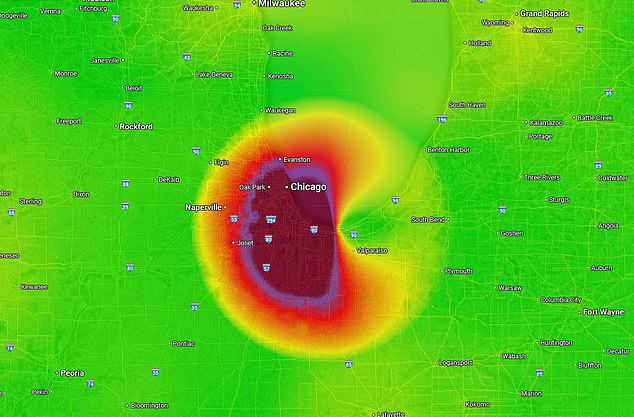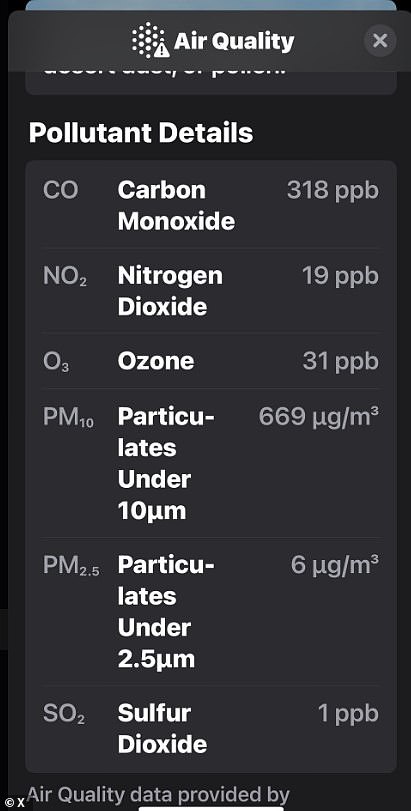A concerning air quality mystery has broken out in Chicago, as the city has reportedly been blanketed with toxic chemicals.
Air quality maps revealed an enormous cloud of hazardous air sitting over the entire Chicago metropolitan area Wednesday afternoon, with readings reaching 500 on the Air Quality Index (AQI) – the worst possible score on Google Maps.
An AQI of 500 denotes extremely hazardous air quality, where pollutant levels are at or beyond the upper limits of what monitoring systems typically measure which typically only happens during massive wildfires or volcanic eruptions.
The news comes as Chicago was just found to have some of the worst air quality in the US. Chicago specifically ranked poorly in particle pollution – which refers to tiny solid or liquid particles suspended in the air that people can breathe in.
While both Google and Apple customers received alarming messages about the apparent emergency, the news has actually caused more confusion than panic.
Residents in the Chicago area took to social media Wednesday afternoon to share what their smartphones were telling them about the conditions outside – with many saying there was no emergency at all, according to other air quality trackers.
However, one person posted an image on Reddit, revealing that the AQI in Chicago had reached 405 just after noon ET.
‘How dangerous is it for me and my kid to be outside today?’ they asked.

Google Maps revealed a massive cloud of hazardous sitting over Chicago, Illinois on Wednesday
One person revealed on X that they had received an air quality alert message on their phone, warning that ‘everyone is even more likely to experience serious health effects.’
Another person on X shared a message from their son, showing that Chicago’s air was inundated with both carbon monoxide and PM10 – meaning particulate matter with a diameter of 10 micrometers or smaller.
Both are toxic to humans, but they harm the body in different ways and vary in their toxicity depending on exposure levels and duration.
The readings, taken at 2pm ET, showed that Chicago was seeing carbon monoxide levels of 318 ppb (parts per billion) in their air.
While that level is relatively low in terms of outdoor air quality, the amount of fine particulate matter in the air set off alarm bells on Google Maps’ air quality tracking system.
Chicago’s reported PM10 concentration of 669 µg/m³ (micrograms per cubic meter) is extremely bad and fell into the ‘Hazardous’ category of the Air Quality Index, indicating serious health risks for everyone.
However, many on Reddit argued that both AccuWeather and IQAir had listed the city’s air quality as either ‘fair’ or ‘good.’
Conversely, air quality readings produced by Apple were also registering a major problem in the Chicago area on Wednesday.

Social media users on X shared disturbing images of what appeared to be an air quality emergency in Chicago Wednesday afternoon

Levels of fine particulate matter reportedly reached extremely hazardous levels and set off air quality alerts on mobile phones
‘Why is my iPhone weather app telling me that Chicago’s air quality is hazardous right now but other websites say otherwise?’ an X user asked.
Some commenters suspected that the extreme air quality emergency may have been nothing more than a glitch in software.
IQAir reported that there were only a handful of small fires being reported on in the Wednesday, but nothing large enough to cause an environmental emergency.
Dr Vin Gupta, a pulmonologist in Washington’s Seattle area, told DailyMail.com: ‘An air quality of 500 or more is typically associated with some acute event, like wildfire smoke or smoke from a burning building. You typically don’t see those things unless there is a major acute event that has occurred.’
Chicago is known for poor air quality. The American Lung Association’s newly released State of the Air report lists the windy city as 15th overall for levels of smog, worse than it’s ranking in the last two yearly reports, in which it ranked 17th.
‘Years of successful cleanup of emissions from transportation, energy generation and industrial processes have contributed to falling ozone levels across much of the country since … 2000,’ according to the report, which analyzed 2023 air quality data collected by the Environmental Protection Agency.
‘Unfortunately, as was shown in 2023, one bad fire season has the potential to offset that progress, at least temporarily, creating new challenges for air pollution control efforts and putting the health of the communities affected at increased risk.’






